The Impact of Poverty and Resilience Factors: A Detailed Analysis
VerifiedAdded on 2019/10/31
|9
|2880
|219
Essay
AI Summary
This essay delves into the multifaceted issue of poverty, examining its impact and the resilience of affected populations. It explores both geographical factors, such as climate change and population density, and socioeconomic factors, including access to education and resource availability, highlighting their direct influence on poverty levels. The essay emphasizes the vulnerability of developing countries and the importance of adaptation strategies. It further analyzes how these factors force poor individuals to develop resilience, adopting various coping mechanisms to secure a sustainable livelihood. The conclusion underscores the need for comprehensive approaches to address poverty and foster resilience, thereby improving living standards and access to essential resources.
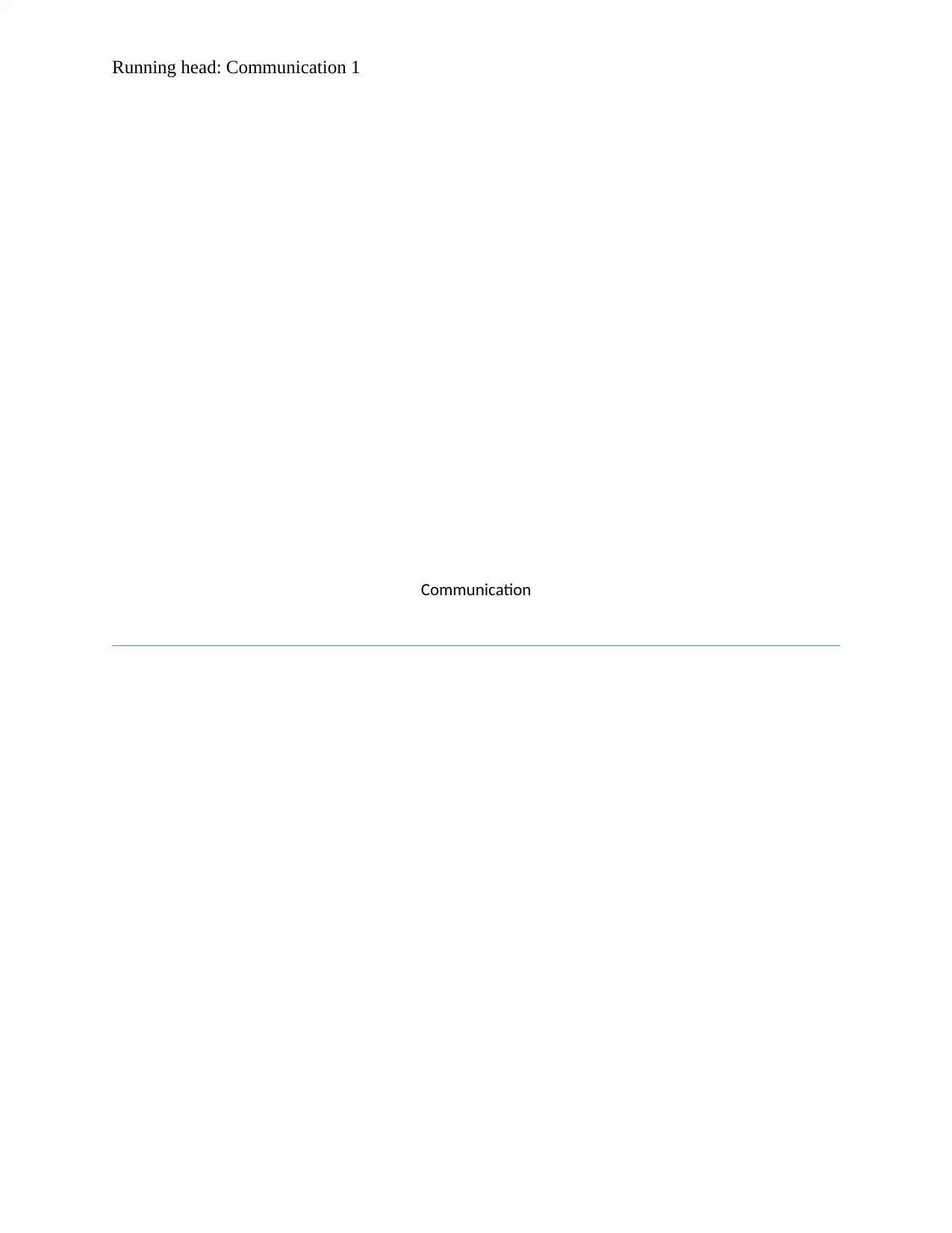
Running head: Communication 1
Communication
Communication
Paraphrase This Document
Need a fresh take? Get an instant paraphrase of this document with our AI Paraphraser
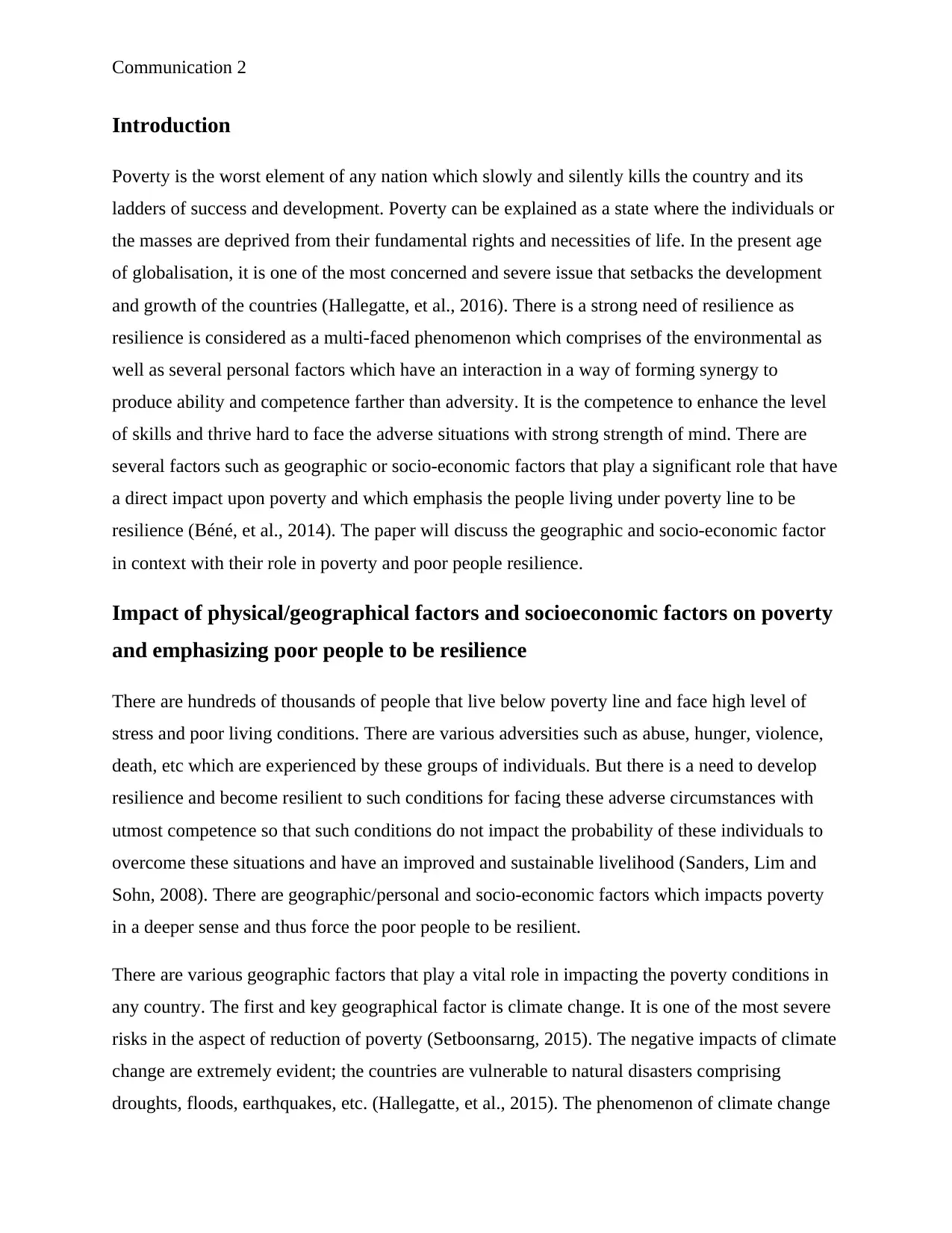
Communication 2
Introduction
Poverty is the worst element of any nation which slowly and silently kills the country and its
ladders of success and development. Poverty can be explained as a state where the individuals or
the masses are deprived from their fundamental rights and necessities of life. In the present age
of globalisation, it is one of the most concerned and severe issue that setbacks the development
and growth of the countries (Hallegatte, et al., 2016). There is a strong need of resilience as
resilience is considered as a multi-faced phenomenon which comprises of the environmental as
well as several personal factors which have an interaction in a way of forming synergy to
produce ability and competence farther than adversity. It is the competence to enhance the level
of skills and thrive hard to face the adverse situations with strong strength of mind. There are
several factors such as geographic or socio-economic factors that play a significant role that have
a direct impact upon poverty and which emphasis the people living under poverty line to be
resilience (Béné, et al., 2014). The paper will discuss the geographic and socio-economic factor
in context with their role in poverty and poor people resilience.
Impact of physical/geographical factors and socioeconomic factors on poverty
and emphasizing poor people to be resilience
There are hundreds of thousands of people that live below poverty line and face high level of
stress and poor living conditions. There are various adversities such as abuse, hunger, violence,
death, etc which are experienced by these groups of individuals. But there is a need to develop
resilience and become resilient to such conditions for facing these adverse circumstances with
utmost competence so that such conditions do not impact the probability of these individuals to
overcome these situations and have an improved and sustainable livelihood (Sanders, Lim and
Sohn, 2008). There are geographic/personal and socio-economic factors which impacts poverty
in a deeper sense and thus force the poor people to be resilient.
There are various geographic factors that play a vital role in impacting the poverty conditions in
any country. The first and key geographical factor is climate change. It is one of the most severe
risks in the aspect of reduction of poverty (Setboonsarng, 2015). The negative impacts of climate
change are extremely evident; the countries are vulnerable to natural disasters comprising
droughts, floods, earthquakes, etc. (Hallegatte, et al., 2015). The phenomenon of climate change
Introduction
Poverty is the worst element of any nation which slowly and silently kills the country and its
ladders of success and development. Poverty can be explained as a state where the individuals or
the masses are deprived from their fundamental rights and necessities of life. In the present age
of globalisation, it is one of the most concerned and severe issue that setbacks the development
and growth of the countries (Hallegatte, et al., 2016). There is a strong need of resilience as
resilience is considered as a multi-faced phenomenon which comprises of the environmental as
well as several personal factors which have an interaction in a way of forming synergy to
produce ability and competence farther than adversity. It is the competence to enhance the level
of skills and thrive hard to face the adverse situations with strong strength of mind. There are
several factors such as geographic or socio-economic factors that play a significant role that have
a direct impact upon poverty and which emphasis the people living under poverty line to be
resilience (Béné, et al., 2014). The paper will discuss the geographic and socio-economic factor
in context with their role in poverty and poor people resilience.
Impact of physical/geographical factors and socioeconomic factors on poverty
and emphasizing poor people to be resilience
There are hundreds of thousands of people that live below poverty line and face high level of
stress and poor living conditions. There are various adversities such as abuse, hunger, violence,
death, etc which are experienced by these groups of individuals. But there is a need to develop
resilience and become resilient to such conditions for facing these adverse circumstances with
utmost competence so that such conditions do not impact the probability of these individuals to
overcome these situations and have an improved and sustainable livelihood (Sanders, Lim and
Sohn, 2008). There are geographic/personal and socio-economic factors which impacts poverty
in a deeper sense and thus force the poor people to be resilient.
There are various geographic factors that play a vital role in impacting the poverty conditions in
any country. The first and key geographical factor is climate change. It is one of the most severe
risks in the aspect of reduction of poverty (Setboonsarng, 2015). The negative impacts of climate
change are extremely evident; the countries are vulnerable to natural disasters comprising
droughts, floods, earthquakes, etc. (Hallegatte, et al., 2015). The phenomenon of climate change
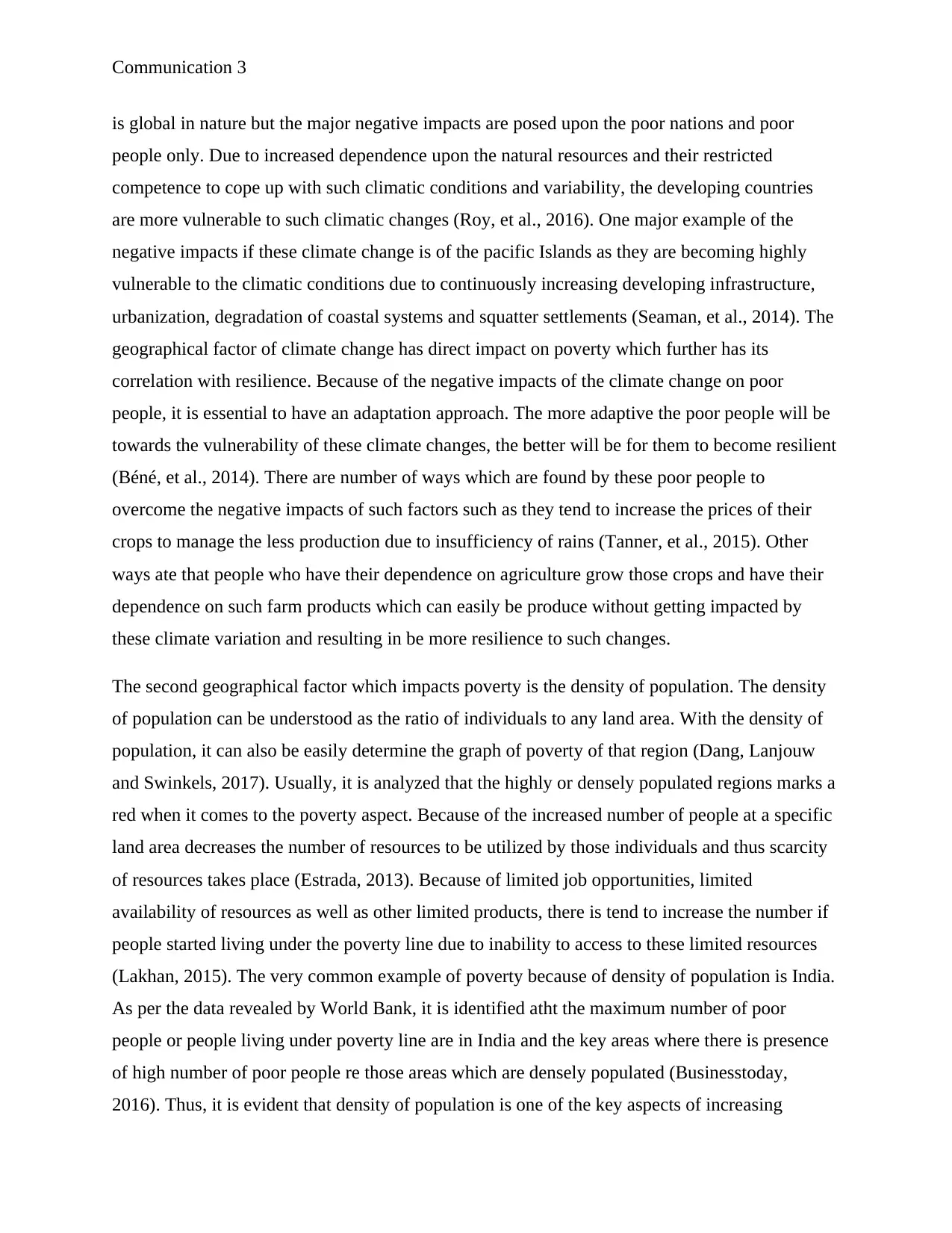
Communication 3
is global in nature but the major negative impacts are posed upon the poor nations and poor
people only. Due to increased dependence upon the natural resources and their restricted
competence to cope up with such climatic conditions and variability, the developing countries
are more vulnerable to such climatic changes (Roy, et al., 2016). One major example of the
negative impacts if these climate change is of the pacific Islands as they are becoming highly
vulnerable to the climatic conditions due to continuously increasing developing infrastructure,
urbanization, degradation of coastal systems and squatter settlements (Seaman, et al., 2014). The
geographical factor of climate change has direct impact on poverty which further has its
correlation with resilience. Because of the negative impacts of the climate change on poor
people, it is essential to have an adaptation approach. The more adaptive the poor people will be
towards the vulnerability of these climate changes, the better will be for them to become resilient
(Béné, et al., 2014). There are number of ways which are found by these poor people to
overcome the negative impacts of such factors such as they tend to increase the prices of their
crops to manage the less production due to insufficiency of rains (Tanner, et al., 2015). Other
ways ate that people who have their dependence on agriculture grow those crops and have their
dependence on such farm products which can easily be produce without getting impacted by
these climate variation and resulting in be more resilience to such changes.
The second geographical factor which impacts poverty is the density of population. The density
of population can be understood as the ratio of individuals to any land area. With the density of
population, it can also be easily determine the graph of poverty of that region (Dang, Lanjouw
and Swinkels, 2017). Usually, it is analyzed that the highly or densely populated regions marks a
red when it comes to the poverty aspect. Because of the increased number of people at a specific
land area decreases the number of resources to be utilized by those individuals and thus scarcity
of resources takes place (Estrada, 2013). Because of limited job opportunities, limited
availability of resources as well as other limited products, there is tend to increase the number if
people started living under the poverty line due to inability to access to these limited resources
(Lakhan, 2015). The very common example of poverty because of density of population is India.
As per the data revealed by World Bank, it is identified atht the maximum number of poor
people or people living under poverty line are in India and the key areas where there is presence
of high number of poor people re those areas which are densely populated (Businesstoday,
2016). Thus, it is evident that density of population is one of the key aspects of increasing
is global in nature but the major negative impacts are posed upon the poor nations and poor
people only. Due to increased dependence upon the natural resources and their restricted
competence to cope up with such climatic conditions and variability, the developing countries
are more vulnerable to such climatic changes (Roy, et al., 2016). One major example of the
negative impacts if these climate change is of the pacific Islands as they are becoming highly
vulnerable to the climatic conditions due to continuously increasing developing infrastructure,
urbanization, degradation of coastal systems and squatter settlements (Seaman, et al., 2014). The
geographical factor of climate change has direct impact on poverty which further has its
correlation with resilience. Because of the negative impacts of the climate change on poor
people, it is essential to have an adaptation approach. The more adaptive the poor people will be
towards the vulnerability of these climate changes, the better will be for them to become resilient
(Béné, et al., 2014). There are number of ways which are found by these poor people to
overcome the negative impacts of such factors such as they tend to increase the prices of their
crops to manage the less production due to insufficiency of rains (Tanner, et al., 2015). Other
ways ate that people who have their dependence on agriculture grow those crops and have their
dependence on such farm products which can easily be produce without getting impacted by
these climate variation and resulting in be more resilience to such changes.
The second geographical factor which impacts poverty is the density of population. The density
of population can be understood as the ratio of individuals to any land area. With the density of
population, it can also be easily determine the graph of poverty of that region (Dang, Lanjouw
and Swinkels, 2017). Usually, it is analyzed that the highly or densely populated regions marks a
red when it comes to the poverty aspect. Because of the increased number of people at a specific
land area decreases the number of resources to be utilized by those individuals and thus scarcity
of resources takes place (Estrada, 2013). Because of limited job opportunities, limited
availability of resources as well as other limited products, there is tend to increase the number if
people started living under the poverty line due to inability to access to these limited resources
(Lakhan, 2015). The very common example of poverty because of density of population is India.
As per the data revealed by World Bank, it is identified atht the maximum number of poor
people or people living under poverty line are in India and the key areas where there is presence
of high number of poor people re those areas which are densely populated (Businesstoday,
2016). Thus, it is evident that density of population is one of the key aspects of increasing
⊘ This is a preview!⊘
Do you want full access?
Subscribe today to unlock all pages.

Trusted by 1+ million students worldwide

Communication 4
poverty. The geographical factor of density of population has direct impact on poverty which
further has its correlation with resilience. Because of the negative impacts of the density of
population on poor people, it is essential to have a collaborative and shared approach
(Leichenko, 2011). The poop people usually have a more sharing approach with the other people
of their groups which help them to cope up with the situation of scarcity of the resources and
limited materials because of high population. But there develops resilience by these poor people
to live up in such circumstances by sharing and having even distribution of land, resources and
jobs (Akter and Mallick, 2013). This is one of the ways they overcome such circumstances and
manage living under poverty line.
There are various socioeconomic factors that play a vital role in impacting the poverty conditions
in any country. The first and key socioeconomic factor is lack of access to education. For any
developing and developed economy, education is one of the most essential elements as well as
the relevant education is of high importance (Bhalla and Lapeyre, 2016). The people living
below poverty line are deprived of the educational facilities and thus there is a lack of access to
education. The key example of this is that in several developing nations, there are still hundreds
of villages and rural areas where the right to education is restricted (Acemoglu and Robinson,
2013). Because of the lack of access to education, the masses are not able to study and get
qualified and thus there is increased level of unemployment in the developing countries. The
socioeconomic factor of lack of access to education has a direct impact on poverty which further
has its correlation with resilience (Reardon, 2015). There is a need to develop resilience by the
poor people to overcome the impact of these factors and thus for this, the people living below
poverty line have their dependence upon the government education as well as educational
facilities offered by several non-government organisations (Béné, et al., 2011). The poor people
are forced to be resilience by getting qualified from taking education from these institutes. These
people try to take more of vocational as well as technical trainings instead of bookish knowledge
so that they can effectively use these training in their farming and other employment aspects. The
knowledge gained by these institutes and government education centres, there is a way to
resilience the poverty related issues and attain an improved livelihood (Yeh, et al., 2008).
The second socioeconomic factor that plays a vital role in impacting the poverty conditions in
any country is the limited availability of the resources. The situational deprivation and natural
poverty. The geographical factor of density of population has direct impact on poverty which
further has its correlation with resilience. Because of the negative impacts of the density of
population on poor people, it is essential to have a collaborative and shared approach
(Leichenko, 2011). The poop people usually have a more sharing approach with the other people
of their groups which help them to cope up with the situation of scarcity of the resources and
limited materials because of high population. But there develops resilience by these poor people
to live up in such circumstances by sharing and having even distribution of land, resources and
jobs (Akter and Mallick, 2013). This is one of the ways they overcome such circumstances and
manage living under poverty line.
There are various socioeconomic factors that play a vital role in impacting the poverty conditions
in any country. The first and key socioeconomic factor is lack of access to education. For any
developing and developed economy, education is one of the most essential elements as well as
the relevant education is of high importance (Bhalla and Lapeyre, 2016). The people living
below poverty line are deprived of the educational facilities and thus there is a lack of access to
education. The key example of this is that in several developing nations, there are still hundreds
of villages and rural areas where the right to education is restricted (Acemoglu and Robinson,
2013). Because of the lack of access to education, the masses are not able to study and get
qualified and thus there is increased level of unemployment in the developing countries. The
socioeconomic factor of lack of access to education has a direct impact on poverty which further
has its correlation with resilience (Reardon, 2015). There is a need to develop resilience by the
poor people to overcome the impact of these factors and thus for this, the people living below
poverty line have their dependence upon the government education as well as educational
facilities offered by several non-government organisations (Béné, et al., 2011). The poor people
are forced to be resilience by getting qualified from taking education from these institutes. These
people try to take more of vocational as well as technical trainings instead of bookish knowledge
so that they can effectively use these training in their farming and other employment aspects. The
knowledge gained by these institutes and government education centres, there is a way to
resilience the poverty related issues and attain an improved livelihood (Yeh, et al., 2008).
The second socioeconomic factor that plays a vital role in impacting the poverty conditions in
any country is the limited availability of the resources. The situational deprivation and natural
Paraphrase This Document
Need a fresh take? Get an instant paraphrase of this document with our AI Paraphraser
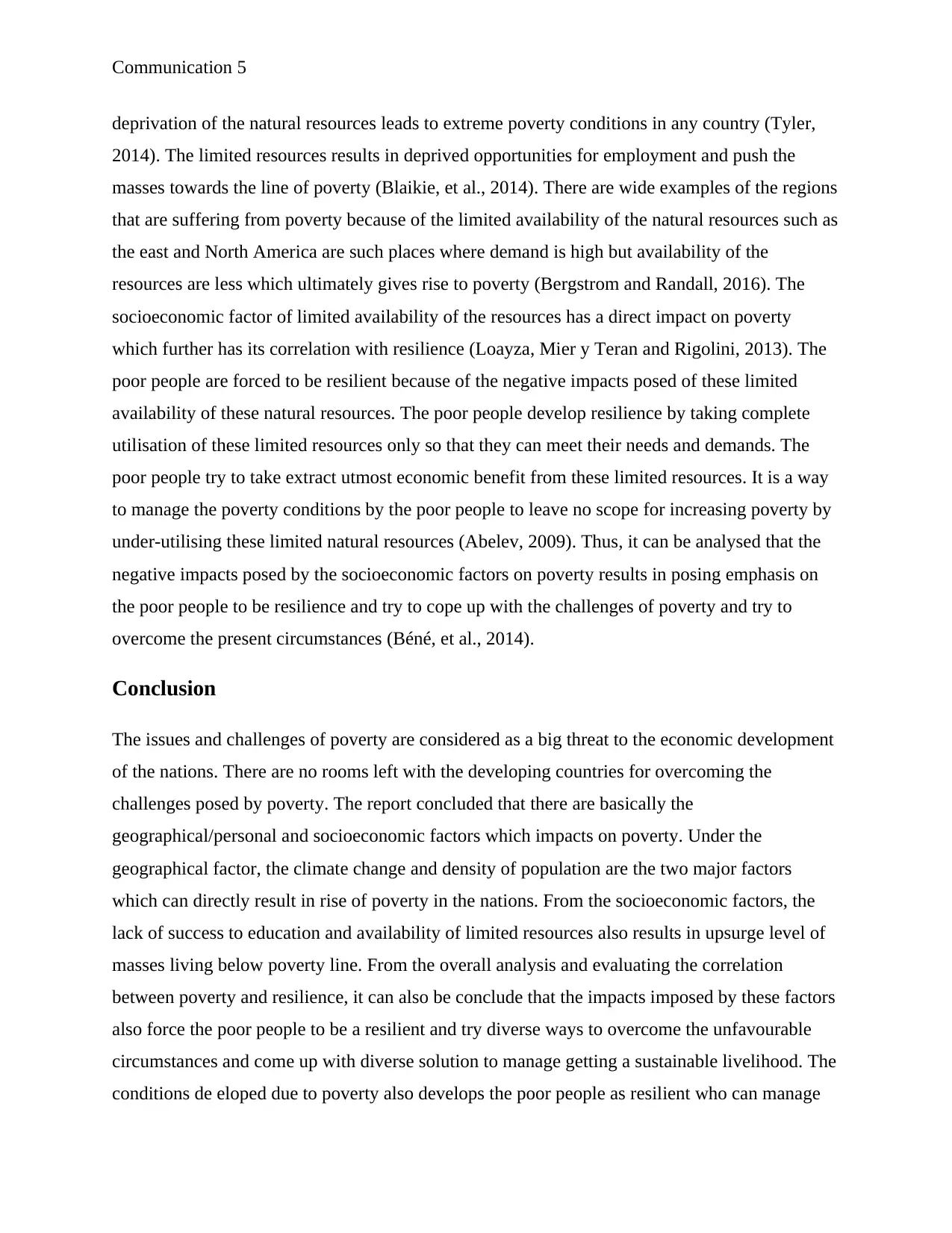
Communication 5
deprivation of the natural resources leads to extreme poverty conditions in any country (Tyler,
2014). The limited resources results in deprived opportunities for employment and push the
masses towards the line of poverty (Blaikie, et al., 2014). There are wide examples of the regions
that are suffering from poverty because of the limited availability of the natural resources such as
the east and North America are such places where demand is high but availability of the
resources are less which ultimately gives rise to poverty (Bergstrom and Randall, 2016). The
socioeconomic factor of limited availability of the resources has a direct impact on poverty
which further has its correlation with resilience (Loayza, Mier y Teran and Rigolini, 2013). The
poor people are forced to be resilient because of the negative impacts posed of these limited
availability of these natural resources. The poor people develop resilience by taking complete
utilisation of these limited resources only so that they can meet their needs and demands. The
poor people try to take extract utmost economic benefit from these limited resources. It is a way
to manage the poverty conditions by the poor people to leave no scope for increasing poverty by
under-utilising these limited natural resources (Abelev, 2009). Thus, it can be analysed that the
negative impacts posed by the socioeconomic factors on poverty results in posing emphasis on
the poor people to be resilience and try to cope up with the challenges of poverty and try to
overcome the present circumstances (Béné, et al., 2014).
Conclusion
The issues and challenges of poverty are considered as a big threat to the economic development
of the nations. There are no rooms left with the developing countries for overcoming the
challenges posed by poverty. The report concluded that there are basically the
geographical/personal and socioeconomic factors which impacts on poverty. Under the
geographical factor, the climate change and density of population are the two major factors
which can directly result in rise of poverty in the nations. From the socioeconomic factors, the
lack of success to education and availability of limited resources also results in upsurge level of
masses living below poverty line. From the overall analysis and evaluating the correlation
between poverty and resilience, it can also be conclude that the impacts imposed by these factors
also force the poor people to be a resilient and try diverse ways to overcome the unfavourable
circumstances and come up with diverse solution to manage getting a sustainable livelihood. The
conditions de eloped due to poverty also develops the poor people as resilient who can manage
deprivation of the natural resources leads to extreme poverty conditions in any country (Tyler,
2014). The limited resources results in deprived opportunities for employment and push the
masses towards the line of poverty (Blaikie, et al., 2014). There are wide examples of the regions
that are suffering from poverty because of the limited availability of the natural resources such as
the east and North America are such places where demand is high but availability of the
resources are less which ultimately gives rise to poverty (Bergstrom and Randall, 2016). The
socioeconomic factor of limited availability of the resources has a direct impact on poverty
which further has its correlation with resilience (Loayza, Mier y Teran and Rigolini, 2013). The
poor people are forced to be resilient because of the negative impacts posed of these limited
availability of these natural resources. The poor people develop resilience by taking complete
utilisation of these limited resources only so that they can meet their needs and demands. The
poor people try to take extract utmost economic benefit from these limited resources. It is a way
to manage the poverty conditions by the poor people to leave no scope for increasing poverty by
under-utilising these limited natural resources (Abelev, 2009). Thus, it can be analysed that the
negative impacts posed by the socioeconomic factors on poverty results in posing emphasis on
the poor people to be resilience and try to cope up with the challenges of poverty and try to
overcome the present circumstances (Béné, et al., 2014).
Conclusion
The issues and challenges of poverty are considered as a big threat to the economic development
of the nations. There are no rooms left with the developing countries for overcoming the
challenges posed by poverty. The report concluded that there are basically the
geographical/personal and socioeconomic factors which impacts on poverty. Under the
geographical factor, the climate change and density of population are the two major factors
which can directly result in rise of poverty in the nations. From the socioeconomic factors, the
lack of success to education and availability of limited resources also results in upsurge level of
masses living below poverty line. From the overall analysis and evaluating the correlation
between poverty and resilience, it can also be conclude that the impacts imposed by these factors
also force the poor people to be a resilient and try diverse ways to overcome the unfavourable
circumstances and come up with diverse solution to manage getting a sustainable livelihood. The
conditions de eloped due to poverty also develops the poor people as resilient who can manage

Communication 6
their living and have dome of the other way to cope up. Thus, it can stated that the resilience
aspect of the poor people will help them to cross the poverty line and have a good living standard
with adequate access to the basic necessities and other facilities necessary for sustainable
livelihood.
their living and have dome of the other way to cope up. Thus, it can stated that the resilience
aspect of the poor people will help them to cross the poverty line and have a good living standard
with adequate access to the basic necessities and other facilities necessary for sustainable
livelihood.
⊘ This is a preview!⊘
Do you want full access?
Subscribe today to unlock all pages.

Trusted by 1+ million students worldwide
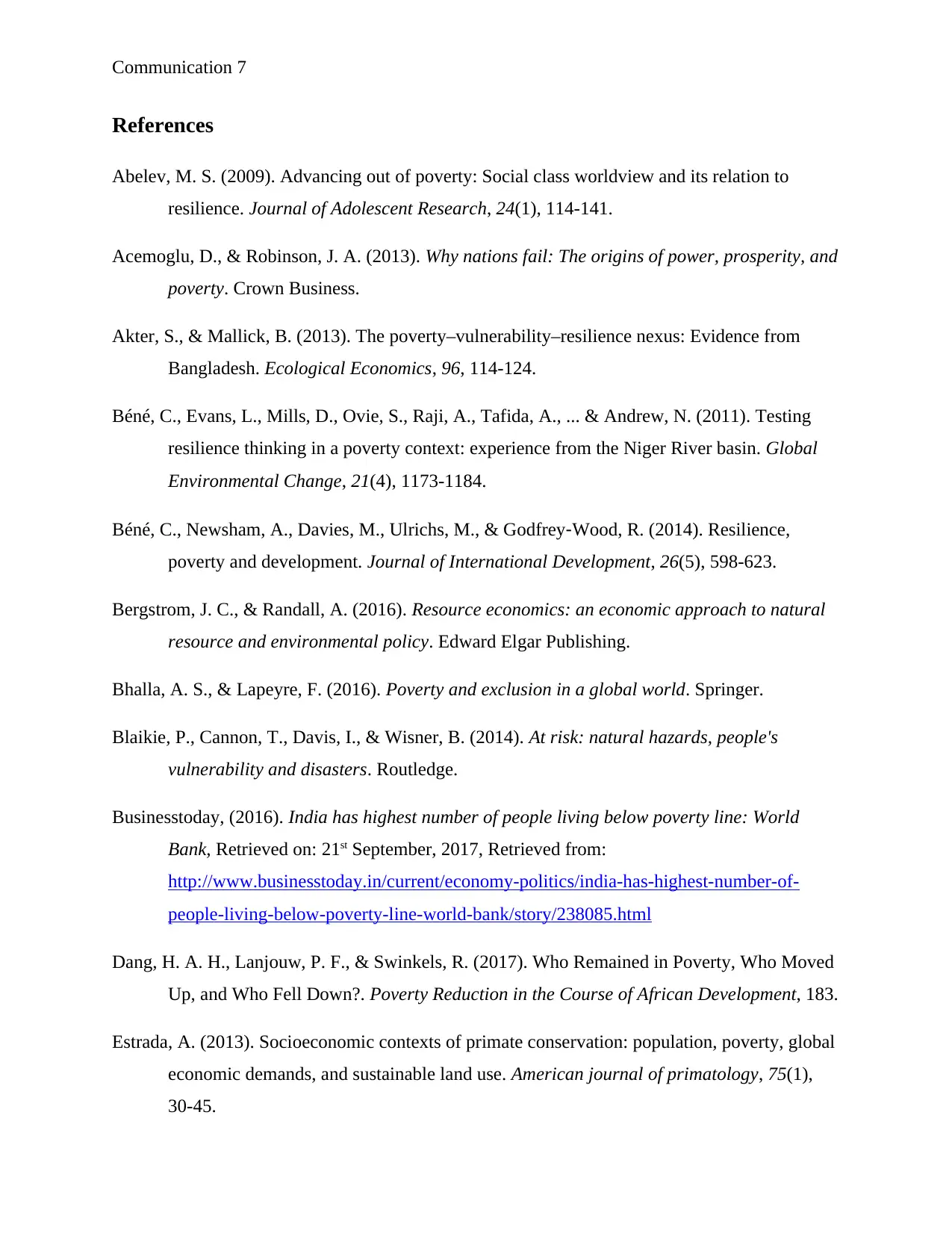
Communication 7
References
Abelev, M. S. (2009). Advancing out of poverty: Social class worldview and its relation to
resilience. Journal of Adolescent Research, 24(1), 114-141.
Acemoglu, D., & Robinson, J. A. (2013). Why nations fail: The origins of power, prosperity, and
poverty. Crown Business.
Akter, S., & Mallick, B. (2013). The poverty–vulnerability–resilience nexus: Evidence from
Bangladesh. Ecological Economics, 96, 114-124.
Béné, C., Evans, L., Mills, D., Ovie, S., Raji, A., Tafida, A., ... & Andrew, N. (2011). Testing
resilience thinking in a poverty context: experience from the Niger River basin. Global
Environmental Change, 21(4), 1173-1184.
Béné, C., Newsham, A., Davies, M., Ulrichs, M., & Godfrey‐Wood, R. (2014). Resilience,
poverty and development. Journal of International Development, 26(5), 598-623.
Bergstrom, J. C., & Randall, A. (2016). Resource economics: an economic approach to natural
resource and environmental policy. Edward Elgar Publishing.
Bhalla, A. S., & Lapeyre, F. (2016). Poverty and exclusion in a global world. Springer.
Blaikie, P., Cannon, T., Davis, I., & Wisner, B. (2014). At risk: natural hazards, people's
vulnerability and disasters. Routledge.
Businesstoday, (2016). India has highest number of people living below poverty line: World
Bank, Retrieved on: 21st September, 2017, Retrieved from:
http://www.businesstoday.in/current/economy-politics/india-has-highest-number-of-
people-living-below-poverty-line-world-bank/story/238085.html
Dang, H. A. H., Lanjouw, P. F., & Swinkels, R. (2017). Who Remained in Poverty, Who Moved
Up, and Who Fell Down?. Poverty Reduction in the Course of African Development, 183.
Estrada, A. (2013). Socioeconomic contexts of primate conservation: population, poverty, global
economic demands, and sustainable land use. American journal of primatology, 75(1),
30-45.
References
Abelev, M. S. (2009). Advancing out of poverty: Social class worldview and its relation to
resilience. Journal of Adolescent Research, 24(1), 114-141.
Acemoglu, D., & Robinson, J. A. (2013). Why nations fail: The origins of power, prosperity, and
poverty. Crown Business.
Akter, S., & Mallick, B. (2013). The poverty–vulnerability–resilience nexus: Evidence from
Bangladesh. Ecological Economics, 96, 114-124.
Béné, C., Evans, L., Mills, D., Ovie, S., Raji, A., Tafida, A., ... & Andrew, N. (2011). Testing
resilience thinking in a poverty context: experience from the Niger River basin. Global
Environmental Change, 21(4), 1173-1184.
Béné, C., Newsham, A., Davies, M., Ulrichs, M., & Godfrey‐Wood, R. (2014). Resilience,
poverty and development. Journal of International Development, 26(5), 598-623.
Bergstrom, J. C., & Randall, A. (2016). Resource economics: an economic approach to natural
resource and environmental policy. Edward Elgar Publishing.
Bhalla, A. S., & Lapeyre, F. (2016). Poverty and exclusion in a global world. Springer.
Blaikie, P., Cannon, T., Davis, I., & Wisner, B. (2014). At risk: natural hazards, people's
vulnerability and disasters. Routledge.
Businesstoday, (2016). India has highest number of people living below poverty line: World
Bank, Retrieved on: 21st September, 2017, Retrieved from:
http://www.businesstoday.in/current/economy-politics/india-has-highest-number-of-
people-living-below-poverty-line-world-bank/story/238085.html
Dang, H. A. H., Lanjouw, P. F., & Swinkels, R. (2017). Who Remained in Poverty, Who Moved
Up, and Who Fell Down?. Poverty Reduction in the Course of African Development, 183.
Estrada, A. (2013). Socioeconomic contexts of primate conservation: population, poverty, global
economic demands, and sustainable land use. American journal of primatology, 75(1),
30-45.
Paraphrase This Document
Need a fresh take? Get an instant paraphrase of this document with our AI Paraphraser
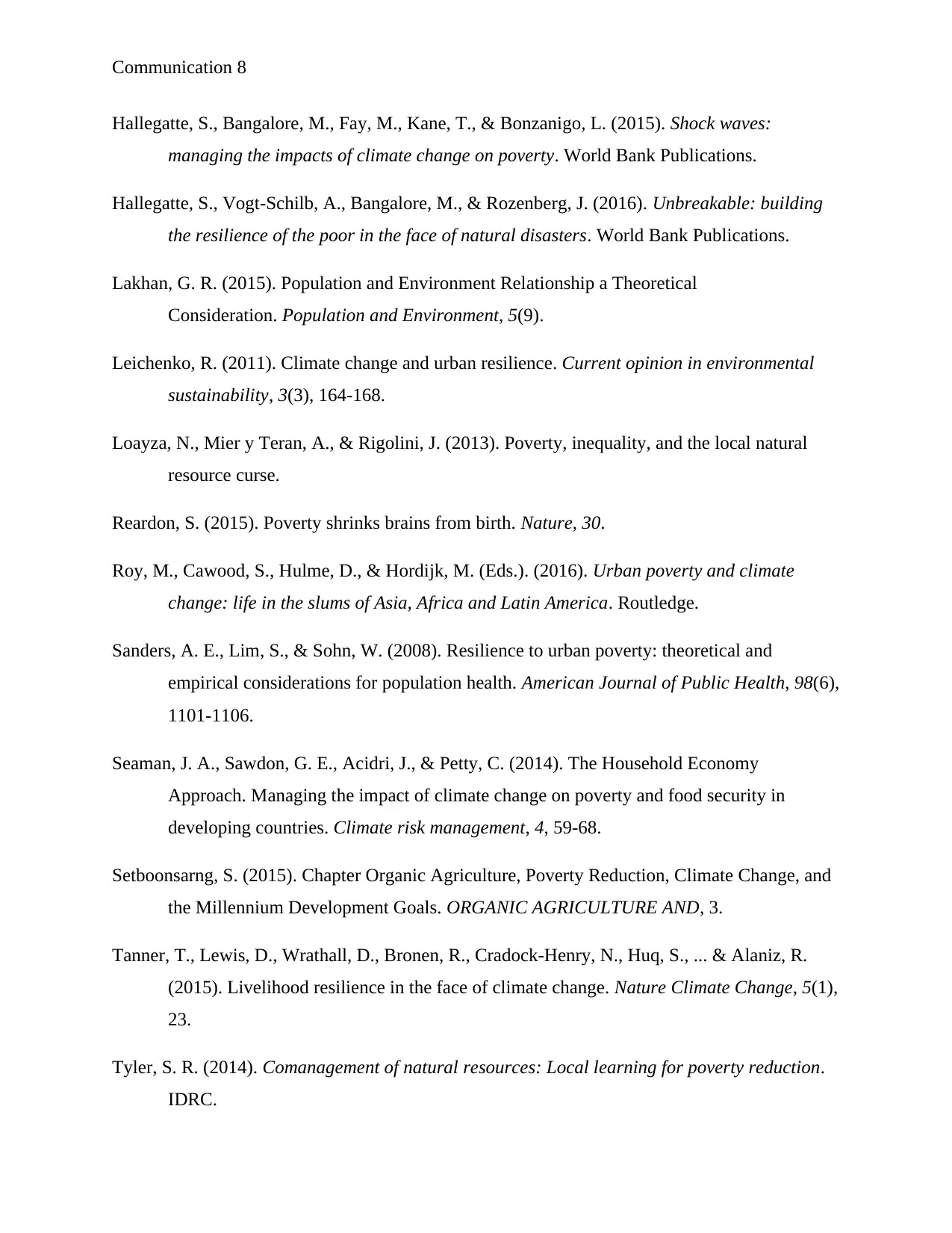
Communication 8
Hallegatte, S., Bangalore, M., Fay, M., Kane, T., & Bonzanigo, L. (2015). Shock waves:
managing the impacts of climate change on poverty. World Bank Publications.
Hallegatte, S., Vogt-Schilb, A., Bangalore, M., & Rozenberg, J. (2016). Unbreakable: building
the resilience of the poor in the face of natural disasters. World Bank Publications.
Lakhan, G. R. (2015). Population and Environment Relationship a Theoretical
Consideration. Population and Environment, 5(9).
Leichenko, R. (2011). Climate change and urban resilience. Current opinion in environmental
sustainability, 3(3), 164-168.
Loayza, N., Mier y Teran, A., & Rigolini, J. (2013). Poverty, inequality, and the local natural
resource curse.
Reardon, S. (2015). Poverty shrinks brains from birth. Nature, 30.
Roy, M., Cawood, S., Hulme, D., & Hordijk, M. (Eds.). (2016). Urban poverty and climate
change: life in the slums of Asia, Africa and Latin America. Routledge.
Sanders, A. E., Lim, S., & Sohn, W. (2008). Resilience to urban poverty: theoretical and
empirical considerations for population health. American Journal of Public Health, 98(6),
1101-1106.
Seaman, J. A., Sawdon, G. E., Acidri, J., & Petty, C. (2014). The Household Economy
Approach. Managing the impact of climate change on poverty and food security in
developing countries. Climate risk management, 4, 59-68.
Setboonsarng, S. (2015). Chapter Organic Agriculture, Poverty Reduction, Climate Change, and
the Millennium Development Goals. ORGANIC AGRICULTURE AND, 3.
Tanner, T., Lewis, D., Wrathall, D., Bronen, R., Cradock-Henry, N., Huq, S., ... & Alaniz, R.
(2015). Livelihood resilience in the face of climate change. Nature Climate Change, 5(1),
23.
Tyler, S. R. (2014). Comanagement of natural resources: Local learning for poverty reduction.
IDRC.
Hallegatte, S., Bangalore, M., Fay, M., Kane, T., & Bonzanigo, L. (2015). Shock waves:
managing the impacts of climate change on poverty. World Bank Publications.
Hallegatte, S., Vogt-Schilb, A., Bangalore, M., & Rozenberg, J. (2016). Unbreakable: building
the resilience of the poor in the face of natural disasters. World Bank Publications.
Lakhan, G. R. (2015). Population and Environment Relationship a Theoretical
Consideration. Population and Environment, 5(9).
Leichenko, R. (2011). Climate change and urban resilience. Current opinion in environmental
sustainability, 3(3), 164-168.
Loayza, N., Mier y Teran, A., & Rigolini, J. (2013). Poverty, inequality, and the local natural
resource curse.
Reardon, S. (2015). Poverty shrinks brains from birth. Nature, 30.
Roy, M., Cawood, S., Hulme, D., & Hordijk, M. (Eds.). (2016). Urban poverty and climate
change: life in the slums of Asia, Africa and Latin America. Routledge.
Sanders, A. E., Lim, S., & Sohn, W. (2008). Resilience to urban poverty: theoretical and
empirical considerations for population health. American Journal of Public Health, 98(6),
1101-1106.
Seaman, J. A., Sawdon, G. E., Acidri, J., & Petty, C. (2014). The Household Economy
Approach. Managing the impact of climate change on poverty and food security in
developing countries. Climate risk management, 4, 59-68.
Setboonsarng, S. (2015). Chapter Organic Agriculture, Poverty Reduction, Climate Change, and
the Millennium Development Goals. ORGANIC AGRICULTURE AND, 3.
Tanner, T., Lewis, D., Wrathall, D., Bronen, R., Cradock-Henry, N., Huq, S., ... & Alaniz, R.
(2015). Livelihood resilience in the face of climate change. Nature Climate Change, 5(1),
23.
Tyler, S. R. (2014). Comanagement of natural resources: Local learning for poverty reduction.
IDRC.
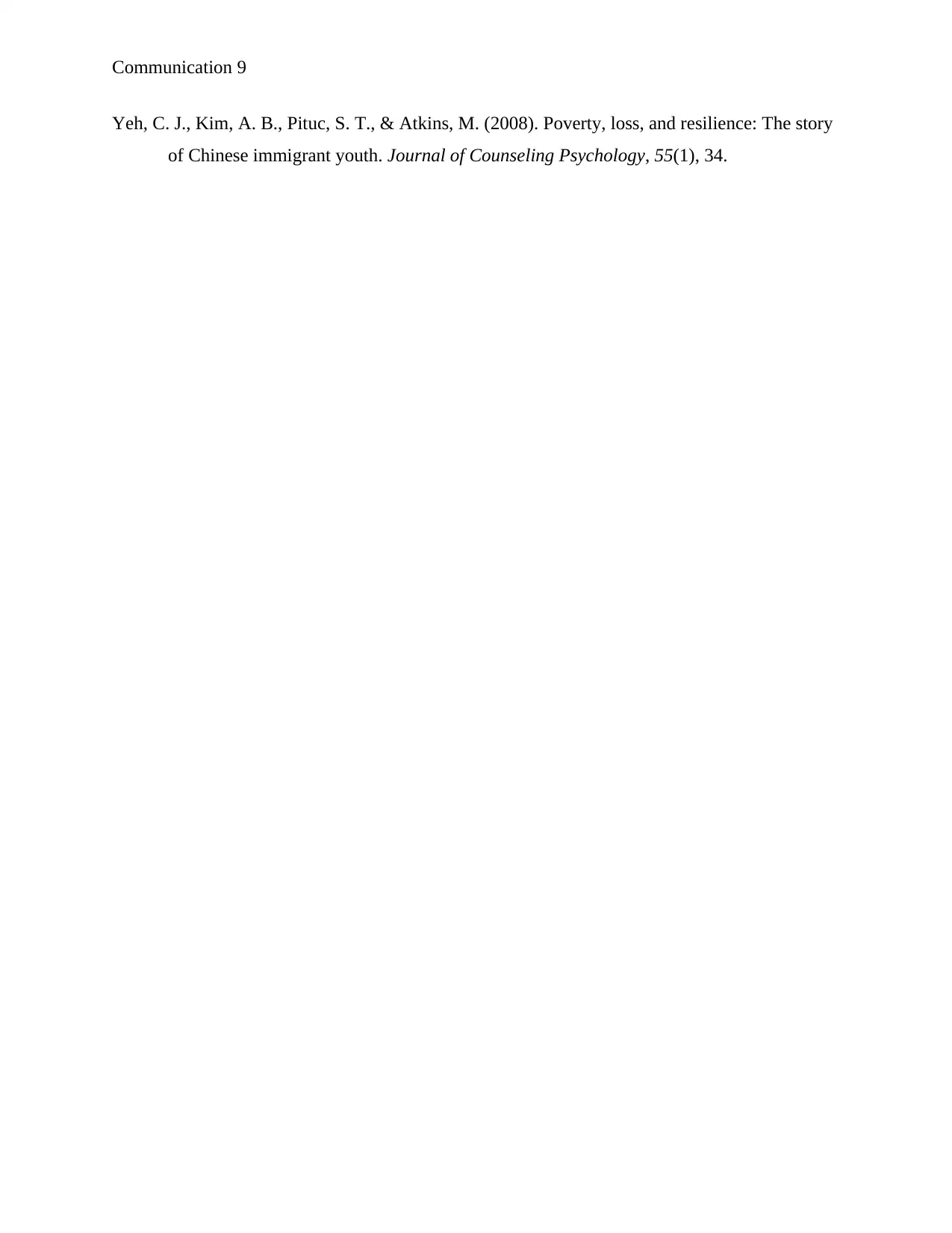
Communication 9
Yeh, C. J., Kim, A. B., Pituc, S. T., & Atkins, M. (2008). Poverty, loss, and resilience: The story
of Chinese immigrant youth. Journal of Counseling Psychology, 55(1), 34.
Yeh, C. J., Kim, A. B., Pituc, S. T., & Atkins, M. (2008). Poverty, loss, and resilience: The story
of Chinese immigrant youth. Journal of Counseling Psychology, 55(1), 34.
⊘ This is a preview!⊘
Do you want full access?
Subscribe today to unlock all pages.

Trusted by 1+ million students worldwide
1 out of 9
Related Documents
Your All-in-One AI-Powered Toolkit for Academic Success.
+13062052269
info@desklib.com
Available 24*7 on WhatsApp / Email
![[object Object]](/_next/static/media/star-bottom.7253800d.svg)
Unlock your academic potential
Copyright © 2020–2025 A2Z Services. All Rights Reserved. Developed and managed by ZUCOL.





